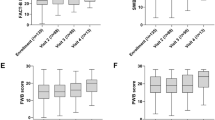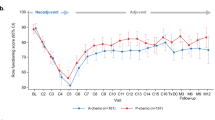Abstract
The randomized phase III trial EGF100151 demonstrated that the combination of lapatinib plus capecitabine (L + C) significantly improved time to progression (TTP) compared with capecitabine alone (C) in heavily pretreated patients with HER2+ (ErbB2+) advanced or metastatic breast cancer. This analysis assessed the effects of study treatments on quality of life (QOL) among patients in EGF100151. Quality of life was assessed using the Functional Assessment of Cancer Therapy-Breast (FACT-B) and EuroQoL (EQ-5D) questionnaires. Patients completed questionnaires during efficacy and safety assessment visits (i.e., at screening visit, every 6 weeks for the first 24 weeks, every 12 weeks thereafter, and at discontinuation of study treatment). Primary analyses compared the treatment groups based on change from baseline QOL. Exploratory analyses compared proportion of patients achieving minimum important differences (MID) in QOL scores and the relationship between QOL and tumor status. Quality of life for patients in both treatment groups was maintained during 24 weeks of follow-up. Adjusted mean changes from baseline in all QOL scores for the L + C arm were comparable to those for the C arm. The between-group differences ranged from 0.7 to 2.2 (FACT-B total) and 0.3 to 1.8 (EQ-5D visual analog scale) and were consistently in favor of the L + C arm, although not statistically significant. Patients with an objective tumor response or stable disease showed clinically meaningful differences in QOL scores compared to patients with progressive disease. A greater proportion of patients receiving L + C versus C achieved the MID for all five QOL scores, although differences were not statistically significant. The addition of lapatinib to capecitabine significantly increases TTP without any evidence of a deleterious effect on patients’ QOL, confirming its clinical benefit in this heavily pretreated patient population with advanced HER2+ breast cancer that has progressed on trastuzumab therapy.





Similar content being viewed by others
References
Coleman RE (1997) Skeletal complications of malignancy. Cancer 80:1588–1594. doi:10.1002/(SICI)1097-0142(19971015)80:8+<1588::AID-CNCR9>3.0.CO;2-G
Lin NU, Bellon JR, Winer EP (2004) CNS metastases in breast cancer. J Clin Oncol 22:3608–3617. doi:10.1200/JCO.2004.01.175
Lin NU, Winer EP (2007) Brain metastases: the HER2 paradigm. Clin Cancer Res 13:1648–1655. doi:10.1158/1078-0432.CCR-06-2478
Mundy GR (2002) Metastasis to bone: causes, consequences and therapeutic opportunities. Nat Rev Cancer 2:584–593. doi:10.1038/nrc867
Goodwin PJ, Ennis M, Bordeleau LJ et al (2004) Health-related quality of life and psychosocial status in breast cancer prognosis: analysis of multiple variables. J Clin Oncol 22:4184–4192. doi:10.1200/JCO.2004.12.091
Brady MJ, Cella DF, Mo F et al (1997) Reliability and validity of the functional assessment of cancer therapy-breast quality-of-life instrument. J Clin Oncol 15:974–986
Bottomley A, Therasse P (2002) Quality of life in patients undergoing systemic therapy for advanced breast cancer. Lancet Oncol 3:620–628. doi:10.1016/S1470-2045(02)00876-8
Barnholtz-Sloan JS, Sloan AE, Davis FG et al (2004) Incidence proportions of brain metastases in patients diagnosed (1973 to 2001) in the metropolitan detroit cancer surveillance system. J Clin Oncol 22:2865–2872. doi:10.1200/JCO.2004.12.149
Slamon DJ, Clark GM, Wong SG et al (1987) Human breast cancer: correlation of relapse and survival with amplification of the HER-2/neu oncogene. Science 235:177–182. doi:10.1126/science.3798106
Bernard-Marty C, Lebrun F, Awada A et al (2006) Monoclonal antibody-based targeted therapy in breast cancer: current status and future directions. Drugs 66:1577–1591. doi:10.2165/00003495-200666120-00004
Piccart MJ, de Valeriola D, Dal Lago L et al (2005) Adjuvant chemotherapy in 2005: standards and beyond. Breast 14:439–445. doi:10.1016/j.breast.2005.08.004
Piccart-Gebhart MJ, Procter M, Leyland-Jones B et al (2005) Trastuzumab after adjuvant chemotherapy in HER2-positive breast cancer. N Engl J Med 353:1659–1672. doi:10.1056/NEJMoa052306
Romond EH, Perez EA, Bryant J et al (2005) Trastuzumab plus adjuvant chemotherapy for operable HER2-positive breast cancer. N Engl J Med 353:1673–1684. doi:10.1056/NEJMoa052122
Montemurro F, Donadio M, Clavarezza M et al (2006) Outcome of patients with HER2-positive advanced breast cancer progressing during trastuzumab-based therapy. Oncologist 11:318–324. doi:10.1634/theoncologist.11-4-318
Tripathy D, Slamon DJ, Cobleigh M et al (2004) Safety of treatment of metastatic breast cancer with trastuzumab beyond disease progression. J Clin Oncol 22:1063–1070. doi:10.1200/JCO.2004.06.557
Xia W, Mullin RJ, Keith BR et al (2002) Anti-tumor activity of GW572016: a dual tyrosine kinase inhibitor blocks EGF activation of EGFR/erbB2 and downstream Erk1/2 and AKT pathways. Oncogene 21:6255–6263. doi:10.1038/sj.onc.1205794
Cameron D, Casey M, Press M et al (2008) A phase III randomized comparison of lapatinib plus capecitabine versus capecitabine alone in women with advanced breast cancer that has progressed on trastuzumab: updated efficacy and biomarker analyses. Breast Cancer Res Treat 112:533–543. doi:10.1007/s10549-007-9885-0
Geyer CE, Forster J, Lindquist D et al (2006) Lapatinib plus capecitabine for HER2-positive advanced breast cancer. N Engl J Med 355:2733–2743. doi:10.1056/NEJMoa064320
Therasse P, Arbuck SG, Eisenhauer EA et al (2000) New guidelines to evaluate the response to treatment in solid tumors. European organization for research and treatment of cancer, national cancer Institute of the United States, national cancer institute of Canada. J Natl Cancer Inst 92:205–216. doi:10.1093/jnci/92.3.205
The EuroQol Group (1990) EuroQol—a new facility for the measurement of health-related quality of life. Health Policy 16:199–208. doi:10.1016/0168-8510(90)90421-9
Wenzel LB, Fairclough DL, Brady MJ et al (1999) Age-related differences in the quality of life of breast carcinoma patients after treatment. Cancer 86:1768–1774. doi:10.1002/(SICI)1097-0142(19991101)86:9<1768::AID-CNCR19>3.0.CO;2-O
Eton DT, Cella D, Yost KJ et al (2004) A combination of distribution- and anchor-based approaches determined minimally important differences (MIDs) for four endpoints in a breast cancer scale. J Clin Epidemiol 57:898–910. doi:10.1016/j.jclinepi.2004.01.012
Pickard AS, Neary MP, Cella D (2007) Estimation of minimally important differences in EQ-5D utility and VAS scores in cancer. Health Qual Life Outcomes 5:70. doi:10.1186/1477-7525-5-70
Walters SJ, Brazier JE (2005) Comparison of the minimally important difference for two health state utility measures: EQ-5D and SF-6D. Qual Life Res 14:1523–1532. doi:10.1007/s11136-004-7713-0
Weinstein MC, Siegel JE, Gold MR et al (1996) Recommendations of the panel on cost-effectiveness in health and medicine. JAMA 276:1253–1258. doi:10.1001/jama.276.15.1253
Bottomley A, Biganzoli L, Cufer T et al (2004) Randomized, controlled trial investigating short-term health-related quality of life with doxorubicin and paclitaxel versus doxorubicin and cyclophosphamide as first-line chemotherapy in patients with metastatic breast cancer: European organization for research and treatment of cancer breast cancer group, investigational drug branch for breast cancer and the new drug development group study. J Clin Oncol 22:2576–2586. doi:10.1200/JCO.2004.02.037
Kloke O, Klaassen U, Oberhoff C et al (1999) Maintenance treatment with medroxyprogesterone acetate in patients with advanced breast cancer responding to chemotherapy: results of a randomized trial. Essen Breast Cancer Study Group. Breast Cancer Res Treat 55:51–59. doi:10.1023/A:1006169012544
Leplege A, Hunt S (1997) The problem of quality of life in medicine. JAMA 278:47–50. doi:10.1001/jama.278.1.47
Kramer JA, Curran D, Piccart M et al (2000) Randomised trial of paclitaxel versus doxorubicin as first-line chemotherapy for advanced breast cancer: quality of life evaluation using the EORTC QLQ-C30 and the Rotterdam symptom checklist. Eur J Cancer 36:1488–1497. doi:10.1016/S0959-8049(00)00134-9
Acknowledgments
We thank the patients who participated in the study and their families; the medical, nursing, and research staff at the study centers; the independent data and safety monitoring committee; and the monitors, clinical operations staff, data managers, statisticians, and programmers at GlaxoSmithKline. The EGF100151 study and the QOL analysis based on this study and reported in this paper were funded by GlaxoSmithKline. Financial support for medical editorial assistance was provided by GlaxoSmithKline. We also thank Bret A. Wing, PhD, ProEd Communications, Inc.®, for his medical editorial assistance with this manuscript.
Author information
Authors and Affiliations
Corresponding author
Rights and permissions
About this article
Cite this article
Zhou, X., Cella, D., Cameron, D. et al. Lapatinib plus capecitabine versus capecitabine alone for HER2+ (ErbB2+) metastatic breast cancer: quality-of-life assessment. Breast Cancer Res Treat 117, 577–589 (2009). https://doi.org/10.1007/s10549-009-0310-8
Received:
Accepted:
Published:
Issue Date:
DOI: https://doi.org/10.1007/s10549-009-0310-8




